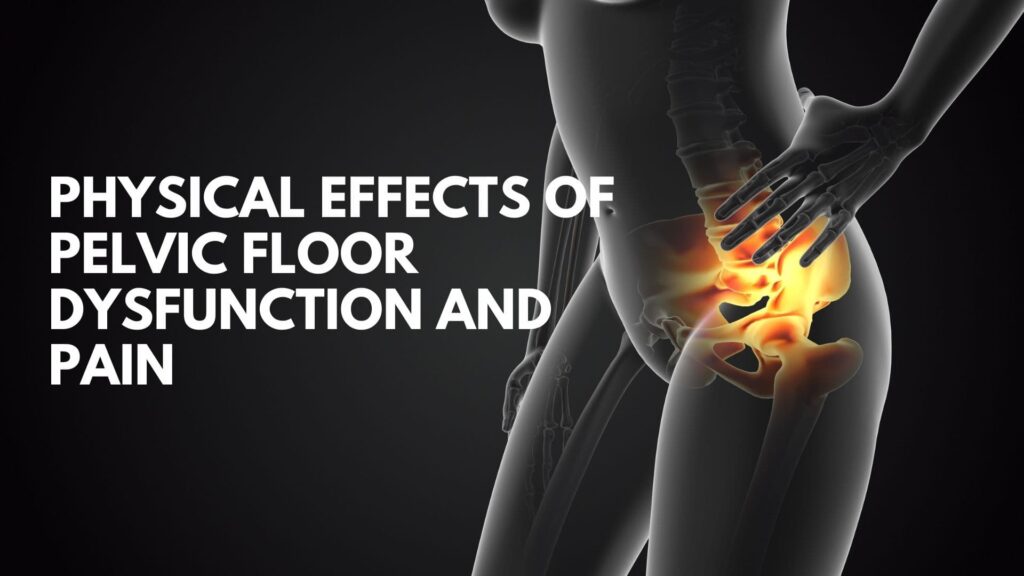The Hidden Biopsychosocial Effects of Pelvic Floor Dysfunction and Pelvic Pain
Did you know that up to 26% of women worldwide deal with pelvic pain? This startling fact highlights the broad effects of chronic pelvic pain and pelvic floor dysfunction in women.
Pelvic floor dysfunction (PFD) and pelvic pain are conditions that affect a significant portion of the population, yet they are often misunderstood and overlooked. These issues can have far-reaching consequences beyond physical symptoms, impacting an individual’s overall well-being and quality of life. They can affect a person’s mind and social life in significant ways.

Biopsychosocial effects of pelvic floor dysfunction and pelvic pain
We will look into the various impacts of pelvic floor dysfunction and pelvic pain, showing how they can influence the body, mind, and social interactions. By understanding these hidden effects, we can find better ways to treat and support people dealing with these conditions, helping them live better lives.
Key Takeaways
- Pelvic pain affects up to 26% of the world’s female population.
- Chronic pelvic pain and pelvic floor dysfunction significantly impact daily life and overall well-being.
- Common pelvic pain conditions include endometriosis, interstitial cystitis, PID, IBS, and musculoskeletal issues like pelvic floor dysfunction.
- Chronic pelvic pain can lead to central sensitization involving the central nervous system.
- Psychological distress such as anxiety and depression frequently accompanies chronic pelvic pain.
- A multidisciplinary approach is most effective for managing pelvic pain.
- Lifestyle modifications like stress reduction, mindfulness, and a balanced diet play a critical role in managing chronic pain.

Understanding pelvic floor dysfunction and pelvic pain
To truly understand pelvic floor issues, we must know their leading causes and effects.
Pelvic floor dysfunction
The pelvic floor is a complex system of muscles, ligaments, and connective tissue that play a crucial role in supporting the organs within the pelvic region, including the bladder, uterus, and rectum. Pelvic floor disorders occur when these structures are not functioning properly, leading to a range of issues such as incontinence, pelvic organ prolapse, and chronic pelvic pain in women.
Pelvic pain
Pelvic pain, on the other hand, is a broad term that encompasses any discomfort or pain experienced in the pelvic region. This pain can stem from a variety of underlying causes, including musculoskeletal problems, painful bladder syndromes, neuropathic pain, or even psychological factors.

Physical effects of pelvic dysfunction and pain
Dealing with pelvic dysfunction brings a range of tough challenges. It affects your body in many ways. You might face issues like trouble with urination and bowel movements, problems in your sexual life, and muscle and joint pain. These issues can really change how you feel day-to-day.
Urinary and bowel dysfunction
Many people with pelvic dysfunction struggle with urination and bowel problems. They might have an overactive bladder or find it hard to control urination. This can make performing their everyday things difficult and stressful.
Sexual dysfunction
Sexual problems are also common with pelvic dysfunction. Those suffering may experience pain or discomfort during sex. Studies show that up to 83% of women with this issue face sexual difficulties. This can really affect relationships and happiness.
Musculoskeletal Issues
Pelvic dysfunction can also cause muscle and joint pain. Pain often comes from weak pelvic floor muscles, which can upset the balance and strength of your pelvic area. Ongoing pain can limit your ability and might require special pelvic floor care to get better.
It’s important to understand and treat the physical effects of pelvic dysfunction. Getting help, like pelvic floor physiotherapy, can make a big difference. It can help manage problems with the pelvic area, including urinary, sexual, and muscle issues. This, in turn, can improve your life a lot.

Psychological effects of pelvic pain and pelvic floor dysfunction
Persistent pain and dysfunction can deeply affect one’s mental state. It may increase feelings of anxiety and depression. When pain is in sensitive spots like the pelvic or urogenital area, it affects your mental health more. Understanding these psychological effects is critical due to their impact on life quality.
Anxiety and depression
Many studies link chronic pelvic pain with higher chances of anxiety and depression. For instance, 72% of people with this pain feel stressed out (Ferreira-Valente et al., 2014). Anxiety and depression make pain feel worse. They also make it harder to manage and treat the pain. This worsens the mental health issues related to pain.
Related interesting read: Postpartum depression
Impact on body image and self-esteem
Pelvic floor dysfunction and pain can hurt self-esteem and how one sees one’s body. People may feel their bodies have betrayed them. This leads to stress from not functioning “normally.” As issues continue, they may view themselves negatively, affecting their self-worth. This heavy emotional load changes how they interact with others.
Emotional distress and loss of enjoyment
Pelvic pain syndrome can take away the joy in life. Many report feeling frustrated and helpless. This can decrease happiness in life. This distress touches many parts of life, from personal to professional, raising mental health issues.
| Condition | Incidence Rate |
|---|---|
| Mental health conditions post-hysterectomy (Laughlin-Tommaso et al., 2020) | 27% |
| De novo lower urinary tract symptoms post-prolapse repair (Tran & Chung, 2017) | 18% |
| Changes in female sexual function post-prolapse repair (Costantini et al., 2013) | 24% |
| Loss of enjoyment and diminished life satisfaction (Dietz et al., 2010) | 21% |
| Improvement in symptoms post-weight loss (Gozukara et al., 2014) | 16% |

Social effects of PFD and pelvic pain
Living with pelvic floor disorders affects individuals deeply. It impacts their personal relationships and daily life. Understanding these effects is crucial for addressing the challenges.
Impact on relationships and intimacy
Pelvic pain affects personal relationships by causing intimacy issues. The discomfort and pain make sexual activities difficult. This often leads to tension and emotional strain between partners.
Research shows pelvic dysfunction also impacts sexual function. It affects life quality across various age groups. Addressing intimacy concerns is, therefore, essential.
Limitations on daily activities and social participation
Pelvic dysfunction limits daily activities and social involvement. It forces people to skip social or work events to manage symptoms like pain and incontinence. This can lead to a disruptive everyday life, fostering a sense of frustration.
These limitations reduce life quality and can cause social isolation. It’s challenging for the affected individuals.
Stigma and lack of awareness
Stigma adds complexity to pelvic dysfunction. Many feel too embarrassed to talk about their condition. This leads to a general lack of awareness and understanding.
Stigma prevents people from seeking help or talking about their issues. It isolates them further and worsens their condition. Education and open discussions are key to fighting this stigma.

Financial effects of pelvic dysfunction and pain
The economic burden of pelvic dysfunction is a big deal because it leads to lots of healthcare costs. This includes many doctor visits, physical therapy, and sometimes even major surgery. People with PFD who don’t get better with muscle training often need surgery.
Healthcare costs and medical interventions
Treating pelvic dysfunction and related pain increases healthcare costs because patients need ongoing care, such as physical therapy, medications, and sometimes surgery. These costs come from diagnostic tests, treatments, surgeries, and regular follow-up visits. Insurance coverage varies, and there are also indirect costs like lost productivity due to frequent medical appointments.
Managing PFD is challenging because it requires coordinated care from different specialists, and patients may have trouble accessing this care or sticking to their treatment plans. We can use integrated care models and telehealth services to reduce costs and focus on preventive care to catch symptoms early and avoid more expensive treatments later.
Loss of productivity and income
The loss of income due to pain has a big impact on patients, making their financial situation even more challenging. Dealing with chronic pain can make it hard for them to work as much. Researchers have found that people from disadvantaged backgrounds often miss their appointments, with rates between 50% and 60% due to financial strain on individuals.
This not only means lost workdays but also lower work performance, which leads to less income and more financial problems.
This ongoing financial pressure means we need proactive medical care to help individuals dealing with this issue.

The interconnected nature of biopsychosocial factors
The biopsychosocial model shows how biological, psychological, and social factors play together. This is especially true when looking at the whole picture of pelvic dysfunction and pain. It’s imperative to consider how all these factors connect for the best care and treatment.
Pelvic pain, for instance, affects many women. It’s not just a physical issue. It also deeply impacts their psychological health and social life.
“Understanding the interconnected health factors is pivotal for managing the multifaceted impacts of pelvic dysfunction,” says leading researchers in the field.
Think about elderly people with dementia who have urinary incontinence. They need special care that looks at not just the physical side but also social challenges. This shows how crucial the biopsychosocial model is.
The table below shows an example of key health factors for women with persistent pain in the pelvis. It outlines how to handle these aspects for a better life.
| Health Factor | Impact | Management Strategy |
|---|---|---|
| Biological | Pelvic persistent pain is a symptom requiring intervention | Pelvic floor physiotherapy, medication, surgical options |
| Psychological | Fear of humiliation, leading to inhibited care-seeking behaviour | Psychological intervention , support, counselling, cognitive-behavioural therapy (CBT) |
| Social | Impact on social participation and stigma | Support groups, community-based interventions, culturally sensitive care |
We need to understand the connections in the biopsychosocial model to give better care. By doing this, healthcare providers can offer treatments that help the whole person. This improves medical care and boosts patients’ well-being and quality of life.

The relationship between stress, cortisol levels, and pelvic pain
It’s vital to understand how stress affects pelvic pain for managing chronic pelvic health issues. Research links significant cortisol effects to pelvic pain. Cortisol is a stress hormone made by your adrenal glands.
Cortisol changes throughout the day. The relationship between stress, cortisol levels, and pelvic pain is intricate and multifaceted. Stress triggers the body’s “fight or flight” response, releasing cortisol, a hormone that helps manage stress. Chronic stress can result in persistently elevated cortisol levels, which may disrupt normal bodily functions and contribute to various health issues, including pain.
Elevated cortisol can lead to increased inflammation and heightened pain sensitivity, exacerbating conditions like endometriosis and irritable bowel syndrome (IBS), which are commonly associated with pain in the pelvis. Consequently, managing stress and regulating cortisol levels can be crucial in alleviating pain in pelvis and improving overall well-being.
Treatments like physiotherapy and psychological intervention can help normalize cortisol levels and improve overall health.

Diagnosis and treatment options
Understanding your pelvic pain starts with the right diagnosis. It might include simple tests, scans like transvaginal ultrasonography, or even a laparoscopy for severe cases. This way, doctors can find the actual cause of your pain.
Comprehensive multidisciplinary approach
A comprehensive multidisciplinary approach to treating pelvic floor dysfunction and pain involves using different types of healthcare professionals to help patients. This can include doctors, physical therapists, and psychologists working together.
Each professional plays a role in helping manage pain, stress and emotional factors. By combining these different treatments, patients can get more complete and effective care for their pelvic floor issues and pain. This approach helps address all aspects of the condition, improving overall health and relief.
Physiotherapy and pelvic floor exercises
Physiotherapy and pelvic floor exercises can be really helpful for people dealing with PFD and pain. In the biopsychosocial model, this approach considers the physical symptoms and how emotions and social factors play a role in the condition. Physiotherapy focuses on strengthening and relaxing the pelvic floor muscles to improve their function, which can reduce pain and discomfort.
Additionally, physiotherapy helps patients manage their condition better by addressing emotional stress and providing support and education. This holistic approach ensures that physical treatment is combined with strategies to handle the psychological and social aspects of pain in the pelvic area, leading to a more comprehensive and effective care plan.
Weight loss and lifestyle changes
For someone dealing with pelvic dysfunction and pain, making changes to their lifestyle and focusing on weight loss can be very helpful. These changes can make a big difference. Losing weight can reduce pressure on the pelvis, which may help lessen pain and improve function.
Lifestyle changes like regular exercise, a healthy diet, and stress management can also help. Exercise strengthens the core muscles and helps with overall health, while a balanced diet can support weight loss and reduce inflammation.
Managing stress and emotional well-being is essential because stress can worsen pain and discomfort. By addressing all these areas, a person can improve their physical health, emotional state, and overall quality of life.
Surgery
When other treatments don’t work, surgery is sometimes considered a treatment option. Surgery might help by fixing physical issues in the pelvic floor that are causing symptoms like pain and prolapse. Improvement in symptoms after surgery can help a person have a better quality of life and reduce the various impacts on psychosocial aspects.

Addressing the psychological effects
Addressing the psychological effects of patients with PFD and pain considers their emotions, thoughts, and social factors alongside physical health. This approach, known as the biopsychosocial aspect, recognizes that biological, psychological, and social factors influence.
Patients may experience anxiety, depression, or stress due to their symptoms, affecting their daily lives and relationships. By integrating psychological intervention, such as counselling or cognitive-behavioural therapy, alongside medical treatment, healthcare providers aim to improve both physical symptoms and emotional well-being. This holistic approach helps patients manage their condition more effectively, enhancing their overall quality of life.

A path forward for improved care and awareness
Pelvic floor dysfunction and pelvic pain are complex conditions that require a comprehensive, biopsychosocial approach to diagnosis and treatment. By addressing the biological, psychological, and social aspects of these disorders, healthcare providers can offer more effective, personalized care. For individuals living with PFD or pelvic pain, understanding the multifaceted nature of their condition can empower them to seek appropriate help and actively participate in their treatment.
As awareness grows and research advances, there is hope for improved prevention, earlier diagnosis, and more effective treatments for pelvic floor disorders. By continuing to break down stigma and promote open discussions about pelvic health, we can ensure that those affected by these conditions receive the comprehensive care and support they need to improve their quality of life.

Cynthia Pathipati – Registered Physiotherapist
Cynthia Pathipati completed her bachelor’s in physiotherapy and is a qualified Registered Physiotherapist in good standing with the College of Physiotherapists of BC with more than 15 yrs of experience. She has Post-Graduate Credentials and Certifications as well as extensive knowledge experience in treating pelvic floor, orthopedic, neurological, vestibular and pain conditions.







